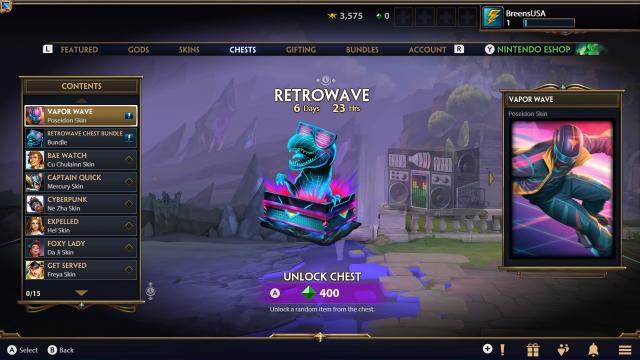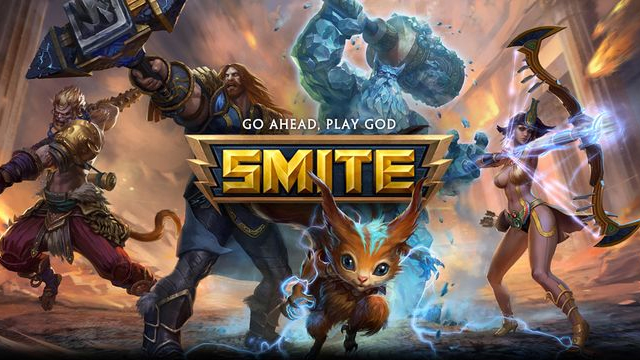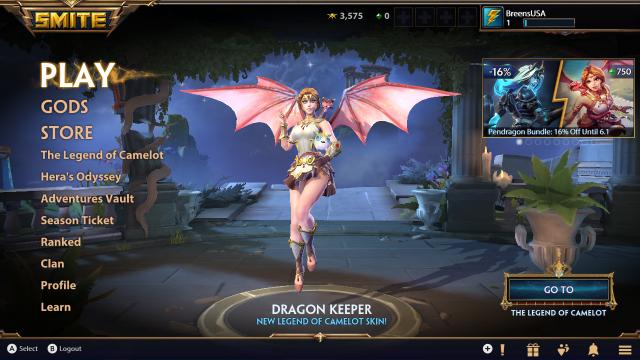Smite‘s recent jump to the Switch hasn’t been smooth. Aside from its floaty combat and the disconnect between the “almighty” Gods and cursor, it’ has a fundamental flaw in its free-to-play design. Even among free-to-play games available on the Switch, Smite should be the last game you decide to play, but its gameplay isn’t what leaves a sour aftertaste. When players enter Smite, the premium currency is the very first thing you become aware of. The main menu screen, in fact, has a character wearing a premium skin as soon as you boot it up. Before you are able to even know what kind of game you are playing, you know it wants your money and it’s makes it clear how poor it is as a free-to-play game.
Smite has so many menus, so many options to dig into, and so many of the heroes you play as, which are all Gods modeled after deities or mythical characters. They look undeniably awesome and make for a great cast along with their skins and voice packs that allow you to customize then ti look flashier than your enemies But it’s all there because you need to invest in it to get the goods. To be entirely fair to Smite, Gods can be earned with in-game currency, and if you play a few games a day you can earn yourself cheaper Gods in a week or two. Dedicated players will always have something new to work towards and the premium currency, Gems, can also be earned in small quantities.
Smite your enemies
Free-to-play games needing money to sustain themselves with microtransactions, and it’s all justifiable if the game is fun and offers enough content and Smite doesn’t. The Legend of Camelot, Hera’s Odyssey, and Adventures Vault are the options on the main menu. All of those, in addition to Play. It appears to be a good selection of modes but it is naïve to think that way. Play is the only actual option to, well, play. All of the others are actually different bundles you can invest in to get new character skins and voice packs, all paid for with the premium currency.
For example, it’s 750 Gems for the Pendragon Bundle section of The Legend of Camelot series. It contains two character skins and two accessory skins. That is the first of five total bundles just in The Legend of Camelot series.
There isn’t a single aspect of this game that doesn’t feel designed to enable microtransactions in an exploitative way. Even the game’s wonderfully large and varied roster was only there to facilitate the payments. Unless you are truly one of the most dedicated players, you won’t be able to unlock all of the Gods in the game through gameplay alone. If you want to work towards getting them all, you’ll need to invest your money in addition to your time.
Of course, this is a free-to-play game, and the developers need to get paid in the end. But seeing the advertisements for new skins, new bundles, new voice packs, new Gods, packed in Smite‘s menus, it’s soulless and feels like it was designed solely by greedy corporate interests. It’s as if you are browsing the pages of a catalog, not playing a game. When stellar free-to-play experiences like Warframe, Fortnite, and Apex Legends that stand on their own with their microtransations, this approach is just not good enough.
There’s one way you can justify Smite‘s overzealous advertisements and monetization: How much is the true price of this content, and does it feel worth the investment? Each God is 200 Gems, but online currency converters don’t offer the option to convert into premium gaming currency, so you need to do the math yourself.
Tax the church

You can pay 200 gems as a flat rate for new Gods, and that will set you back $4.99 (£3.89), which is not an egregious price, by any means. If you log in with a fresh account (as of the time of writing), there will be 89 Gods available for you to unlock. No, that’s not counting the selection that will be unlocked to start with; that’s how many you’ll need to earn. It’s easy to see how that would add up pretty quickly.
But as Gods can be bought in bundles, it’s all of the various skins and voice packs players should worry about. There are dozens upon dozens of skins spread throughout various bundles; some to be bought separately and many in loot box style treasure chests. Some skins are as cheap as 100 Gems, while others can only be purchased in 1,000 Gem bundles, which can include keys to certain season rewards, which are the only way those are accessible.
It gets dizzying pretty quickly, especially when you factor in the cost of a season pass and the loot boxes. There are currently nine different loot boxes, some of them with timed accessibility, so you won’t be able to purchase them past a certain date. Prices went from 20 Gems for the cute emote loot box, and up to 400 Gems for the Retrowave loot box.
If you’re a Smite player and you want a complete collection, be prepared to invest a lot of time and a ton of cash. Your best option is to buy more gems at once to get more for your money, but you have to question whether the investment is worth it for you. And given how much of the game is locked behind money, it feels like a game designed around a monetization system and not the other way around. It’s not healthy for the industry and much less for the game itself.








